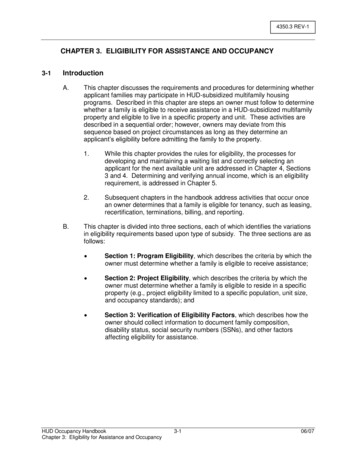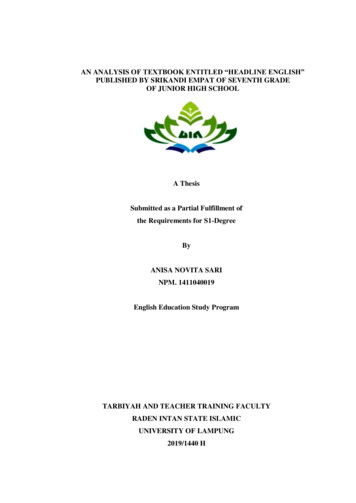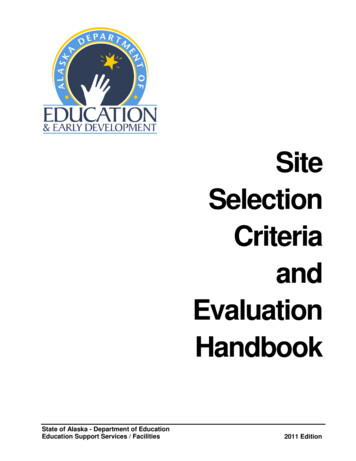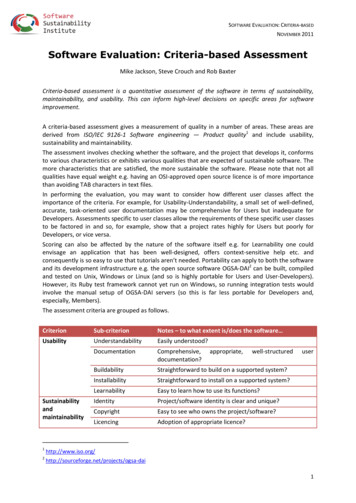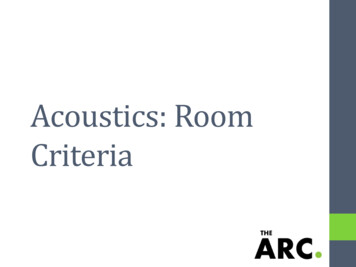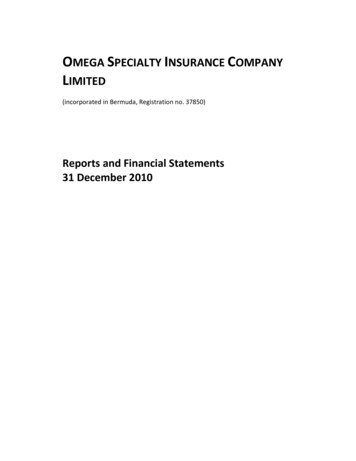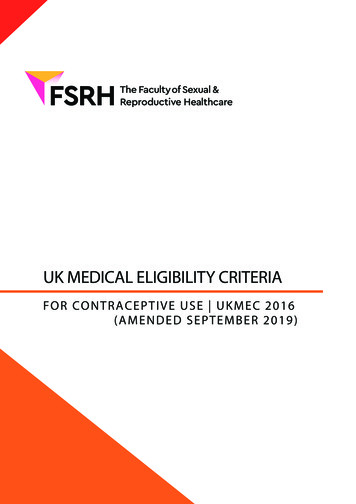
Transcription
UK MEDICAL ELIGIBILITY CRITERIAFOR CONTRACEPTI VE U SE U K ME C 2016(AMEN D E D SE PTE MB E R 2019)
FSRH provided funding to the Clinical Effectiveness Unit (of the FSRH)to assist them in the production of this guidance, the UK Medical Eligibility for Contraceptive Use (2016).Published by the Faculty of Sexual and Reproductive HealthcareRegistered in England No. 2804213 and Registered Charity No. 1019969UKMEC first published in July 2006Copyright Faculty of Sexual and Reproductive Healthcare 2006 to 18 May 2016.This document is also available digitally on our website at www.fsrh.orgPermission is granted to reproduce or transmit this document for non-commercial personal andnon-commercial education use only. Commercial use of any kind, including copying,hiring and lending, is prohibited.Any reproduction of the whole of this document must reproduce this copyright notice in its entirety.Any reproduction of a part of this document must include a statement that it is reproduced under licencefrom FSRH and the notice Copyright Faculty of Sexual and Reproductive Healthcare 2006 to 2016.Published in the UK
Details of changes to original documentSince this document was first published, the following changes have been made:December 2017The UKMEC category for use of progestogen-only injectable contraception by women at high risk ofacquiring HIV has been revised from UKMEC2 (benefits of use generally outweigh risks) to UKMEC1(no restrictions to use).September 2019The UKMEC category for use of progestogen-only injectable contraception and intrauterinecontraception by women at high risk of acquiring HIV has been revised from UKMEC2 (benefits of usegenerally outweigh risks) to UKMEC1 (no restrictions to use).Additional Resource: Diagnosis of Migraine With or Without Aura has been updated to signpostdirectly to the International Headache Society's International Classification of Headache Disorders(3rd edition).
SECTION A: INTRODUCTIONThe UK Medical Eligibility Criteria for Contraceptive Use (UKMEC). 01Development of the UKMEC.01Using the UKMEC.02Contraceptive Choice.04Effectiveness of Contraceptive Method.04Drug Interactions with Hormonal Contraception.05Conditions that May Pose a Significant Health Risk During Pregnancy.06Summary of Changes from UKMEC 2009.0700Copyright Faculty of Sexual and Reproductive Healthcare 2006 to 2016.
The UK medical eligibility criteria for contraceptive use (UKMEC)The UK Medical Eligibility Criteria for Contraceptive Use (UKMEC) offers guidance to providersof contraception regarding who can use contraceptive methods safely. These evidence-basedrecommendations do not indicate a best method for a woman nor do they take into accountefficacy (and this includes drug interactions or malabsorption). The recommendations allow forconsideration of the possible methods that could be used safely by individuals with certain healthconditions (e.g. hypertension) or characteristics (e.g. age) to prevent an unintended pregnancy.Most contraceptive users are medically fit and can use any available contraceptive methodsafely. However, some medical conditions are associated with potential or theoretical increasedhealth risks when certain contraceptive methods are used, either because the methodadversely affects the condition or because the condition or its treatment affects the safety ofthe contraceptive. Since most trials of new contraceptive methods deliberately exclude subjectswith chronic medical conditions, there is often little direct evidence on which to base accurateprescribing advice.Development of the UKMECThe World Health Organization (WHO) developed a set of internationally agreed norms forproviding contraception to individuals with a range of medical conditions that may contraindicateone or more contraceptive methods. The first edition of the WHO Medical Eligibility Criteriafor Contraceptive Use (WHOMEC) was published in 1996. The fifth edition was published in2015 and is available on the WHO website.1 The WHOMEC is primarily intended for use indeveloping countries where the risks associated with pregnancy are often extremely high but itis the intention of WHO that the guidance be adapted for use in different settings in which therisk benefit ratio of contraceptive methods may differ.The first edition of the UKMEC was published in 2006 with a grant from the Department of Health(England).The document was widely distributed to clinicians throughout the United Kingdom(UK) with funding from the Department of Health (England), the Scottish Executive (Scotland)and the Faculty of Sexual and Reproductive Healthcare (FSRH). The second edition of theUKMEC2 was published in 2009. UKMEC 2016 supersedes the second version and has takenaccount of new evidence included in the WHOMEC (fifth edition).The UKMEC update was led by the Clinical Effectiveness Unit (CEU) of the FSRH and involved aguideline development group (GDG) consisting of 19 members (see Appendix 1 for the UKMECdevelopment process and Appendix 2 for the list of contributors). A formal consensus process3was used by the GDG with the aim of making the best use of published evidence and capturingthe collective knowledge of experts in the fields of sexual and reproductive health and alliedspecialties to inform the recommendations included in the UKMEC classifications. The changesin UKMEC 2016 from UKMEC 2009 are summarised and highlighted at the end of Section A.Copyright Faculty of Sexual and Reproductive Healthcare 2006 to 2016.01
USING THE UKMECThe UKMEC considers the following groups of contraceptive methods: intrauterine contraception(IUC), progestogen-only contraception (POC), combined hormonal contraception (CHC) andemergency contraception (EC). The UKMEC categories for each of these groups can be foundin Section B, together with evidence summaries and clarifications. Additional comments can befound at the end of each method section. References and additional resources are located inSection C. Commonly used abbreviations are listed in Appendix 3.The UKMEC CategoriesFor each of the personal characteristics or medical conditions considered by the UKMEC aCategory 1, 2, 3 or 4 is given. The definitions of the categories are given in Table 1.Table 1: Definition of UKMEC categoriesUKMECDEFINITION OF CATEGORYCategory 1A condition for which there is no restriction for the use of the methodCategory 2A condition where the advantages of using the method generally outweigh thetheoretical or proven risksCategory 3A condition where the theoretical or proven risks usually outweigh theadvantages of using the method. The provision of a method requires expertclinical judgement and/or referral to a specialist contraceptive provider, sinceuse of the method is not usually recommended unless other more appropriatemethods are not available or not acceptableCategory 4A condition which represents an unacceptable health risk if the method is usedWhen applied in a clinical setting, a UKMEC Category 1 indicates that there is no restriction foruse. A UKMEC Category 2 indicates that the method can generally be used, but more carefulfollow-up may be required. A contraceptive method with a UKMEC Category 3 can be used;however, it may require expert clinical judgement and/or referral to a specialist contraceptionprovider since use is not usually recommended unless other methods are not available oracceptable. A UKMEC Category 4 indicates that use in that condition poses an unacceptablehealth risk and should not be used.Initiation and Continuation of a MethodThe initiation (I) and continuation (C) of a method of contraception can sometimes be distinguishedand classified differently (see Table 2). The duration of use of a method of contraception prior tothe new onset of a medical condition may influence decisions regarding continued use. However,there is no set duration and clinical judgement will be required.02Copyright Faculty of Sexual and Reproductive Healthcare 2006 to 2016.
Table 2: Initiation and continuation of a method by women with a medical conditionInitiation (I)Starting a method by a woman with a specific medical condition.Continuation (C)Continuing with the method already being used by a woman who developsa new medical condition.For example, the initiation of a progestogen-only pill (POP) is not restricted in a woman with stroke(cerebrovascular accident) as the advantages of using the method generally outweigh the theoreticalor proven risks (UKMEC 2). However, if a woman has a stroke (cerebrovascular accident) whileusing a POP, the continuation of the method will require expert clinical judgement and/or referral toa specialist contraceptive provider because use of that method is not usually recommended unlessother, more appropriate methods are not available or acceptable (UKMEC 3).Using the UKMEC TablesThe UKMEC tables are set out as follows (from left to right, see Table 3): T he first column indicates the CONDITION. Each condition is defined as representing eitheran individual’s characteristics (e.g. age, parity) or a known pre-existing medical condition (e.g.diabetes, hypertension). Some conditions are subdivided to differentiate between varyingdegrees of the condition (e.g. migraine with or without aura). T he CATEGORY (UKMEC 1 to 4) for each CONDITION is given for each method ofcontraception. Occasionally, NA (not applicable) is used, which denotes a condition for whicha ranking was not given but for which clarifications have been provided. T he last column is used to provide CLARIFICATION or to make comment on the EVIDENCEfor the recommendation where appropriate.Table 3: Example of tables in UKMECMETHOD OF CONTRACEPTIONCONDITIONCATEGORYI Initiation,C ContinuationObesityCategory 1, 2, 3 or 4CLARIFICATION/EVIDENCEClarifications and evidence regardingthe condition or classificationCopyright Faculty of Sexual and Reproductive Healthcare 2006 to 2016.03
It is important to note that the UKMEC categories: R elate to the SAFETY of use of a method of contraception by a woman with a particularmedical condition or personal characteristic. The EFFICACY of contraception may be affectedby the condition or by a medication required for the condition but the UKMEC category doesnot reflect this. A re intended to be applied to use of the method of contraception for contraceptive purposes.Where a method of contraception is used for a non-contraceptive indication [e.g. managementof heavy menstrual bleeding (HMB)] the risk/benefit profile and eligibility criteria may differ. C annot simply be added together to indicate the safety of using a method. For example, ifa woman has two conditions that are each UKMEC 2 for use of CHC, these should not beadded to make a UKMEC 4. However, if multiple UKMEC 2 conditions are present that allrelate to the same risk, clinical judgement must be used to decide whether the risks of usingthe method may outweigh the benefits. For example, consider a 34-year-old woman wishingto use CHC who has a body mass index (BMI) of 34 kg/m2 (UKMEC 2), is a current smoker(UKMEC 2), has a history of superficial venous thrombosis (UKMEC 2), and has a first-degreerelative who had a venous thromboembolic event at age 50 years (UKMEC 2), all potentialrisk factors for venous thromboembolism (VTE). She might be better advised to consider adifferent method of contraception that does not increase her risk of VTE. When an individualhas multiple conditions all scoring UKMEC 3 for a method, use of this method may pose anunacceptable risk; clinical judgement should be used in each individual case.Contraceptive ChoiceMany factors determine the method of contraception an individual chooses to use. Providedthe woman is medically eligible to use a particular method, she should be free to choose themethod that is most acceptable to her. To be effective, contraception must be used correctly andconsistently. Effective and continued use of a method is directly related to its acceptability to theuser.Women should be given accurate information about all methods for which they are medicallyeligible and helped to decide which might best suit their needs. Health professionals who giveadvice about contraception should be competent to give information about the efficacy, risksand side effects, advantages and disadvantages, and non-contraceptive benefits of all availablemethods.Information on contraception for women in the UK can be found on the Family PlanningAssociation (fpa) website.4Effectiveness of Contraceptive MethodMethods that require consistent and correct use by individuals have a wide range of effectivenessand can vary greatly with characteristics such as age, socioeconomic status, users’ desires toprevent or delay pregnancy, and culture. Table 4 compares the percentage of women experiencingan unintended pregnancy during the first year of contraceptive use when the method is used‘typically’ (which includes both incorrect and inconsistent use) or ‘perfectly’ (correct and consistentuse).5 Methods considered as long-acting reversible contraception (LARC) are highlighted inTable 4.04Copyright Faculty of Sexual and Reproductive Healthcare 2006 to 2016.
Table 4: Percentage of women experiencing an unintended pregnancy within the firstyear of use with typical use and perfect use (modified from Trussell et al.)5MethodTypical use (%)Perfect use (%)No method8585Fertility awareness-based methods240.4–5Female diaphragm126Male condom182Combined hormonal contraception (CHC)*90.3Progestogen-only pill (POP)90.3Progestogen-only injectable (DMPA)60.2Copper-bearing intrauterine device (Cu-IUD)0.80.6Levonorgestrel-releasing intrauterine system (LNGIUS)0.20.2Progestogen-only implant (IMP)0.050.05Female sterilisation0.50.5Vasectomy0.150.1*Includes combined oral contraception (COC), transdermal patch (patch) and vaginal rings.A pictorial chart on the effectiveness of family planning methods is available from the Centersfor Disease Control and Prevention (CDC) website.6Drug Interactions with Hormonal ContraceptionUse of other medications may increase or decrease serum levels of contraceptive hormones;likewise, hormonal contraception may increase or decrease serum levels of other medications.This can potentially cause adverse effects. Health professionals providing hormonalcontraception should ask women about their current and previous drug use includingprescription, over-the-counter, herbal, recreational drugs, and dietary supplements. Womenshould be advised to use the most effective methods for them; this may include the additionaluse of non-hormonal barrier methods when potential drug interactions pose concern.For further guidance and resources regarding specific contraceptive method/formulation,please refer to F SRH guidance on drug interactions with hormonal contraception,7 available on theFSRH website The British National Formulary (BNF) publications and website.8 S ummary of product characteristics (SPC), available on electronic Medicine Compendium(eMC) website.9Copyright Faculty of Sexual and Reproductive Healthcare 2006 to 2016.05
Online Drug Interaction CheckersThere are online drug interaction checkers available which give useful information on druginteractions. For up-to-date information on the potential drug interactions between hormonalcontraception and antiretroviral (ARV) drugs, please refer to the online HIV drugs interactionchecker.10For up-to-date information on the potential drug interactions between hormonal contraceptionand other drugs, please refer to Stockley's Drug Interactions website.11Please note that the contraceptive effectiveness of DMPA and the LNG-IUS is not reduces byconcurrent use of enzyme-inducing medications.If in doubt please refer to the current FSRH Guideline on Drug Interactions with HormonalContraception.7Conditions that May Pose a Significant Health Risk During PregnancyWomen with conditions that may pose a significant health risk during pregnancy should beadvised to consider using the most effective LARC methods, which provide a highly reliableand effective method of contraception (failure rate 1 pregnancy per 100 women in a year).The sole use of barrier methods and user-dependent methods of contraception (e.g. oralcontraception) may not be the most appropriate choice for these women given their relativelyhigher typical-use failure rates.Some conditions that expose a woman to increased risk as a result of unintended pregnancyinclude but are not limited to: Bariatric surgery within the past 2 years Ischaemic heart disease Breast cancer CardiomyopathyMalignant liver tumours (hepatocellularcarcinoma) Complicated valvular heart disease Morbid obesity (BMI 40 kg/m2) Cystic fibrosis Organ failure/transplant Diabetes: insulin-dependent, or withnephropathy/retinopathy/neuropathy orother vascular disease Rheumatoid arthritis Severe (decompensated) cirrhosis Endometrial or ovarian cancer Sickle cell disease Epilepsy Stroke Gestational trophoblastic neoplasia Systemic lupus erythematosus (SLE) HIV-related diseases Systemic sclerosis Hypertension (systolic 160 mmHg ordiastolic 100 mmHg) Thrombogenic conditions Tuberculosis Teratogenic drugs (see below)06Copyright Faculty of Sexual and Reproductive Healthcare 2006 to 2016.
Women using teratogenic drugs (e.g. methotrexate, some anti-epileptic drugs and retinoids)or drugs with potential teratogenic effects should also be advised to use reliable and effectivecontraception both during treatment and for the recommended timeframe after discontinuation toavoid unintended pregnancies. More information is available from the UK Teratology InformationService (UKTIS) website.12Summary of Changes from UKMEC 2009A total of 27 topics and more than 126 recommendations were reviewed as part of the UKMECrevision. Changes from UKMEC 2009 include the exclusion of some methods and conditions,inclusion of new conditions and ulipristal acetate (UPA) as a new method of EC, removal ofsplit UKMEC categories, revision of sub-conditions and the reordering of the contraceptivemethods in the UKMEC tables.Method Sections No Longer IncludedComprehensive, method-specific FSRH guidance on barrier methods for contraception andsexually transmitted infection (STI) prevention13, fertility awareness methods14 [including thelactational amenorrhoea method (LAM)], and male and female sterilisation15 is available onthe FSRH website. The GDG considered the sections on these methods in the UKMEC as notparticularly helpful and so agreed to remove them.Conditions No Longer IncludedThe following conditions are no longer included in the UKMEC:Schistosomiasis and malaria: These infectious diseases are uncommon in the UKpopulation. Evidence suggests no contraindication to hormonal contraception use with bothconditions (UKMEC 1 for all methods in UKMEC 2009). Please refer to the WHOMEC1 ifrequired.Raynaud’s disease/phenomenon: Expert opinion from UK rheumatologists was that theUKMEC classification given in the UKMEC 2009 was unhelpful/no longer appropriate sincethe risks associated with Raynaud’s disease relate to the underlying disease process ratherthan the condition itself. Raynaud’s disease/phenomenon is therefore no longer included inthe UKMEC.Copyright Faculty of Sexual and Reproductive Healthcare 2006 to 2016.07
Drug interactions: Drug interactions are no longer presented at the end of each methodsection since the recommendations quickly become outdated as new drugs become available.Where appropriate to a specific condition (e.g. HIV infection or epilepsy), references to thesection on drug interactions with hormonal contraception and to relevant online drug interactioncheckers are made.Inclusion of New ConditionsThe new conditions added to the UKMEC include history of bariatric surgery, organ transplant,cardiomyopathy, cardiac arrhythmias, rheumatoid arthritis, and positive antiphospholipidantibodies.The inclusion of these conditions into the UKMEC reflects increasing prevalence of women withthese conditions requesting contraception and the need of contraception providers for guidance.Conditions for which there is a Revision of Sub-condition DescriptionConditions where the sub-conditions have been revised include postpartum, gestationaltrophoblastic disease, cervical cancer, HIV infection, and SLE.Revisions to the sub-condition descriptions have been made to provide guidance that is morespecific/ relevant to the sub-population of women with each condition based on new evidence ordevelopment of clinical practice/opinion.Removal of Split CategoriesAs they were considered unhelpful, split categories (e.g. UKMEC 2/3 or 3/4) are no longerused in the UKMEC for the following conditions: multiple risk factors for cardiovascular disease,known dyslipidaemias, viral hepatitis (acute or flare) and diabetes (nephropathy/retinopathy/neuropathy and other vascular disease).Clarifications have been added or expanded upon to aid clinicians in their judgement regardingwhether a particular method of contraception is safe and appropriate for a woman.Reordering of the Method Categories Presented in the UKMEC TablesThe order of contraceptive methods presented in the UKMEC has been changed to broadlyreflect (from left to right) long-acting, medium-acting and short-acting methods of contraception.Inclusion of Ulipristal Acetate as New Method of Emergency ContraceptionThe UKMEC now includes ulipristal acetate (UPA) as a method of EC. The order of the methodspresented in the UKMEC table reflects the effectiveness of the method (from left to right): copperbearing IUD (Cu-IUD), UPA and levonorgestrel (LNG).Changes to the UKMEC 2009 in the EC section include the addition of obesity as a new condition(UKMEC 1 for all methods) and the expansion of the sub-conditions and UKMEC classificationrecommendations for gestational trophoblastic disease (GTD).08Copyright Faculty of Sexual and Reproductive Healthcare 2006 to 2016.
SUMMARY OF CHANGES FROM UKMEC 2009Conditions for which there has been a classification change for one or more methods or a majormodification to the condition description are highlighted. Conditions that do not appear below remainunchanged.Cu-IUD Copper-bearing intrauterine device; LNG-IUS Levonorgestrel-releasing intrauterine system; IMP Progestogen-only implant; DMPA Progestogen-only injectable: depot medroxyprogesterone acetate; POP Progestogen-only pill; CHC Combined hormonal contraceptionCONDITIONCu-IUDLNGIUSIMPDMPAPOPCHCI Initiation, C ContinuationPERSONAL CHARACTERISTICS AND REPRODUCTIVE HISTORYBreastfeedinga) 0 to 6 weeksb) 6 weeks to 6 months(primarily breastfeeding)See belowc) 6 months12141112111112141213121311121111Postpartum (in non-breastfeeding women)a) 0 to 3 weeks(i) With other risk factors for VTE(ii) Without other risk factorsSee belowb) 3 to 6 weeks(i) With other risk factors for VTE(ii) Without other risk factorsSee belowc) 6 weeksPostpartum (in breastfeeding or nonbreastfeeding women, including postcaesarean section)a) 0 to 48 hours11b) 48 hours to 4 weeks33c) 4 weeks11d) Postpartum sepsis44See aboveUKMECDefinition of categoryCategory 1A condition for which there is no restriction for the use of the methodCategory 2A condition where the advantages of using the method generally outweigh the theoretical or proven risksCategory 3A condition where the theoretical or proven risks usually outweigh the advantages of using the method. Theprovision of a method requires expert clinical judgement and/or referral to a specialist contraceptive provider, sinceuse of the method is not usually recommended unless other more appropriate methods are not available or notacceptableCategory 4A condition which represents an unacceptable health risk if the method is usedCopyright Faculty of Sexual and Reproductive Healthcare 2006 to 2016.09
CONDITIONCu-IUDLNGIUSIMPDMPAPOPCHCI Initiation, C ContinuationHistory of bariatric surgerya) With 30 kg/m2 BMI111111b) With 30–34 kg/m2 BMI111112c) With 35 kg/m2 BMI1111132223Organ transplanta) Complicated: graft failure (acute orchronic),rejection, cardiac allograft vasculopathyICIC3232b) Uncomplicated222222Multiple risk factors for cardiovasculardisease (such as smoking, diabetes,hypertension, obesity and dyslipidaemias)122323Known dyslipidaemias122222a) Normal cardiac function111112b) Impaired cardiac function22222412222412121112CARDIOVASCULAR DISEASE (CVD)CardiomyopathyCardiac arrhythmiasa) Atrial fibrillationb) Known long QT syndromeICIC3131NEUROLOGICAL CONDITIONSIdiopathic intracranial hypertension (IIH)11UKMECDefinition of categoryCategory 1A condition for which there is no restriction for the use of the methodCategory 2A condition where the advantages of using the method generally outweigh the theoretical or proven risksCategory 3A condition where the theoretical or proven risks usually outweigh the advantages of using the method. Theprovision of a method requires expert clinical judgement and/or referral to a specialist contraceptive provider, sinceuse of the method is not usually recommended unless other more appropriate methods are not available or notacceptableCategory 4A condition which represents an unacceptable health risk if the method is used10Copyright Faculty of Sexual and Reproductive Healthcare 2006 to 2016.
CONDITIONCu-IUDLNGIUSIMPDMPAPOPCHCI Initiation, C ContinuationEpilepsy1Taking anti-epileptic drugs11111Certain anti-epileptic drugs have the potential to affectthe bioavailability of steroid hormones in hormonalcontraception. In addition, hormonal contraception mayaffect the levels of certain antic-epileptic drugs with potentialadverse effects.For up-to-date information on the potential drug interactionsbetween hormonal contraception and anti-epileptic drugs,please refer to the online drug interaction checker availableon Stockley’s Interaction Checker website.11BREAST AND REPRODUCTIVE TRACT CONDITIONSGestational trophoblastic disease (GTD)a) Undetectable hCG levels111111b) Decreasing hCG levels331111c) Persistently elevated hCG levels ormalignant disease44111122122Cervical cancera) Awaiting treatmentb) Radical trachelectomyICIC42423322112222b) Benign breast conditions111111c) Family history of breast cancer111111d) Carriers of known gene mutationsassociated with breast cancer (e.g.BRCA1/BRCA2)122223(i) Current breast cancer144444(ii) Past breast cancer133333Breast conditionsa) Undiagnosed mass/breast symptomsIC32e) Breast cancerUKMECDefinition of categoryCategory 1A condition for which there is no restriction for the use of the methodCategory 2A condition where the advantages of using the method generally outweigh the theoretical or proven risksCategory 3A condition where the theoretical or proven risks usually outweigh the advantages of using the method. Theprovision of a method requires expert clinical judgement and/or referral to a specialist contraceptive provider, sinceuse of the method is not usually recommended unless other more appropriate methods are not available or notacceptableCategory 4A condition which represents an unacceptable health risk if the method is usedCopyright Faculty of Sexual and Reproductive Healthcare 2006 to 2016.11
CONDITIONCu-IUDLNGIUSIMPDMPAPOPCHCI Initiation, C ContinuationOvarian cancer111111Sexually transmitted infections (STIs)ICIC(i) Symptomatic42421111(ii) Asymptomatic3232111142421111a) Chlamydial infection (current)b) Purulent cervicitis or gonorrhoea (current)c) Other current STIs (excluding HIV and hepatitis)221111d) Vaginitis (including Trichomonas vaginalisand bacterial vaginosis) (current)221111e) Increased risk for STIs2211111111112211111111HIV INFECTIONHIV Infectiona) High risk of HIV infectionb) HIV infected(i) CD4 count 200 cells/mm3(ii) CD4 count 200 cells/mm3c) Taking antiretroviral (ARV) drugsICIC3232Certain ARV drugs have the potential to affect the bioavailability ofsteroid hormones in hormonal contraception.For up-to-date information on the potential drug interactionsbetween hormonal contraception and ARV drugs, please refer to theonline HIV drugs interaction checker.10UKMECDefinition of categoryCategory 1A condition for which there is no restriction for the use of the methodCategory 2A condition where the advantages of using the method generally outweigh the theoretical or proven risksCategory 3A condition where the theoretical or proven risks usually outweigh the advantages of using the method. Theprovision of a method requires expert clinical judgement and/or referral to a specialist contraceptive provider, sinceuse of the method is not usually recommended unless other more appropriate methods are not available or notacceptableCategory 4A condition which represents an unacceptable health risk if the method is used12Copyright Faculty of Sexual and Reproductive Healthcare 2006 to 2016.
CONDITIONCu-IUDLNGIUSIMPDMPAPOPCHCI Initiation, C ContinuationENDOCRINE CONDITIONSDiabetesa) History of gestational disease111111(i) Non-insulin dependent122222(ii) Insulin-dependent122222c) Nephropathy/retinopathy/neuropathy122223d) Other vascular disease12222311111b) Carrier111111c) Chronic111111122222a) No antiphospholipid antibodies122222b) Positive antiphospholipid antibodies122224Positive antiphospholipid antibodies122224b) Non-vascular diseaseViral hepatitisa) Acute or flareIC32RHEUMATIC DISEASESRheumatoid ar
providing contraception to individuals with a range of medical conditions that may contraindicate one or more contraceptive methods. The first edition of the WHO Medical Eligibility Criteria for Contraceptive Use (WHOMEC) was published in 1996. The fifth edition was
